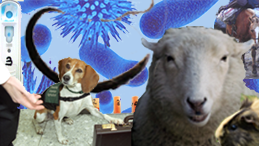
ANSC20003 Topics in Animal Health
Prac 1: Mastitis Diagnostics
Prac 1: Mastitis Diagnostics

Further tests
Having performed the above processes and tests it is likely that you have sufficient information to use the key and identify the cause of mastitis form each of your samples. However there are two further tests that may be required. Unfortunately they would take more days culturing on other plates and therefore they are not included.CAMP Test
(named after the discoverers: ChristieľAtkinsľMunch-Petersen) To identify particular species of Streptococcus this test is used. While Staphylococcus aureus and many species of Streptococcus produce a-haemolysis they can produce ▀-haemolysis when grown in close proximity. Certain chemicals from each combine to produce this effect. This is a primarily method to separate Streptococcus dysgalactiae (CAMP-) from Streptococcus agalactiae (CAMP+).At this stage if you have arrived at this part of the key then without the CAMP test you can only conclude it could be either organism. However that result means you can discuss the outcome in terms of it being either species.
Examining the CAMP test plate
Sabourauds Agar
To differentiate Actinomyces pyogenes from Nocardia species we could plate the organisms on Sabourauds agar as only the later will frow on this agar. It is a selective media, having a pH of 5.6 that is too acidic for moast bacteria but will grow Nocardia and fungal species. If you have arrived at this part of the key then your result will be: Actinomyces pyogenes or Nocardia species. You can discuss this result in terms of it being either. Sabourauds Agar plate showing no growth
Antibiotic Sensitivity Testing
Commonly bacterial identification of a pathogen leads to a further test: Antibiotic Sensitivity Testing. This involves a further plating out of the isolated bacteria. The selected colony is smeared all over the surface of the plate. Several paper disks containing different antibiotics are then placed on the surface. After three more days the plate can be read. Disks that have large areas surrounding them where the bacteria have not grown could be considered for treatments. Areas where the bacteria grow up to the plate would be ineffective against this antibiotic. Areas where the gowth does not grow close to the disk releasing the particular antibiotic can be considered as possible options for treatment. A plate indicating antibiotic sensitivity